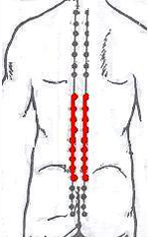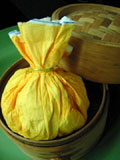|  |
|
|
 |
 |
Home > Examination and Diagnosis > Understanding TCM Specialties
> Women Specialty > Infertility
> TCM Treatment Methods for
Female Infertility > TCM Folk Therapy
|
 |
 |
 |
| |
|
TCM Folk Therapies for Female Infertility
1. TCM Scraping therapy
2. TCM Enema therapy
3. Medicated therapy
4. Umbilical Dressing
5. Medicinal Suppository
|
1. TCM Scraping Therapy
|
This is an old and popular folk therapy. Some scholars believe it is a variation of TCM massage. By using slick rim tools lubricated with vegetable oil or warm water only, the operator scrapes on the patient's neck, shoulder or back. Manipulation is repeated from top to bottom, from inward to outward until the skin area turns a purplish red color. Some of the commonly used tools are glass sticks, tender bamboo films, Chinese tablespoons and coins.
From a TCM viewpoint, this therapy promotes qi and blood circulations, draws perspiration to relieve syndromes of the exterior, benefits the tendons, activates the meridians and also regulates the organs. In the end, various pathogens can be expelled through the body's surface. The therapy can be applied extensively, such as for treatment of sunstroke, flu, motion sickness and food retention.
Sample of module
Repeatedly scrape the following skin areas 10 to 20 times each:
- Scraping the Governor Vessel Meridian : start from the zhi-yang, scrape along the vertebral column to the yao-yu.
- Scraping the Conception Vessel Meridian : start from the zhong-wan, scrape along the meridian to qu-gu, or, start from the tan-zhong, scrape along the middle line to the qu-gu.
- Scraping the Bladder Meridians : start from the gan-shu, scrape downward along the bilateral sides of the vertebral column to the guan-yuan.
|
 |
| The Governor Vessel |
|
 |
| The Conception Vessel |
|
 |
| The Bladder Meridians |
|
|
The whole process will last for about 20 minutes. It is not recommended in chronic and contagious skin conditions or when there are localized lesions in the areas to be scraped.
|
2. TCM Enema Therapy
|
An alternative therapeutic route for medicine administration is by infusing a herbal decoction into the rectum and large intestine. In TCM, this therapy has been used since the Han Dynasty (206 BC - 220 AD). The book Shanghanlun (Treatise on Febrile Diseases) records pig's bile juice being used in this method. Enema therapy has developed rapidly in recent years. It is not only for localized diseases in the rectum and colon, but also widely used in general diseases such as ulcerative colitis, uremia, intestinal obstruction and bronchial asthma. Because of faster absorption through the intestinal membrane, individuals can sometimes attain a faster and more direct result than with oral administration of medicine as well as avoid adverse drug stimulations on the intestines.
After detailed consultation, a TCM physician prescribes the herbal formula and decocts the ingredients into a specified amount and concentration. The resulting liquid should then be filtered into an appropriate container and prepared for infusion. After infusion into the intestine, the decoction should stay for 30 minutes or longer depending on the condition of the individual. This method is recommended for pelvic inflammations or other problems in the pelvis. It should be cautioned in individuals with abdominal pain, undergoing their menses or with vaginal bleeding. |
3. Medicated Compress
|
 |
| The medicinal pack |
|
A kind of external application in TCM by pressing a pad of moistened linen or other material over the body surface repeatedly. There are two types: either using wet dressings saturated with a herbal decoction or a topical compress of heated herbs packed in a bag. This therapy stimulates the communication of the striae, harmonizes the meridians and soothes the blood and qi circulation. The selected herbs are mainly fragrant and pungent in flavors, which facilitate their effects to be absorbed through skin. This is a popular remedy among Chinese families.
From a TCM viewpoint, infertile women usually suffer from excessive coldness in the uterus. With selected herbs pressing on the appropriate body surface, evils like coldness and dampness can be expelled. It helps relieve symptoms of pelvic inflammation or endometriosis.
Sample of compress:
Pack red sage root, infertile leaves, nut grass, gleditsia spine and garden balsam herb in a yarn bag. Place the bag in a steamer to heat up, then apply to the lower abdomen. Another way is to stir-fry the ingredients to heat them, pack in a yarn bag and apply to the lower abdomen. Leave the compress for 20 to 40 minutes or longer. If the bag turns cool, reheat it and apply again.
|
4. Umbilical Dressing
|
In TCM, the navel, which is also called shen-que, is an important acupoint of the body. It has a close relationship with the physiology and pathology of the internal organs, limbs and bones. By stimulating the navel, a medicinal effect infiltrates through the skin and reaches the meridians, activating qi movement and promoting internal balance.
An umbilical dressing is an important external therapy in TCM. Physicians prescribe herbs after a detailed consultation with an individual. They make the ingredients into dosage forms like cream, granules, pills, powder and soft extracts. The drug is pasted on the navel and covered by gauze or tape. Sometimes, physicians will combine this with moxibustion or hot compress therapies.
Sample of dressing:
Herbs like coriander seed, fennel and other invigorating herbs are ground into powder, mixed and packed in a gauze bag and put on the navel. It is then wrapped around the waist with gauze to fix it. The powder should be changed every ten days. This is suitable for infertile women who have excessive cold in the uterus.
|
5. Medicinal Suppository
|
Herbs are made into a suppository form and inserted in the vagina or rectum for healing. According to the literature, this method had already been used for constipation in the Han Dynasty (206 BC - 220 AD). At present, it is not just for localized treatment. Through its membranous absorption in the vagina and rectum, it can exert a generalized effect.
For infertility due to kidney yang deficiency or excessive coldness in the womb, physicians usually choose herbal suppositories made from dodder seed, fresh job's tears, fresh apricot kernel, fresh Asiatic Cornelian cherry fruit, clove and Cnidium fruit. Every night after washing, wrap the suppository with gauze and insert it deep into the vagina. It should stay in place for over four hours. |
|
| |
|
 |
|
|
 |